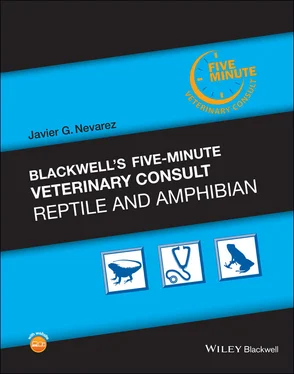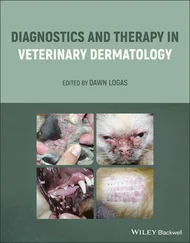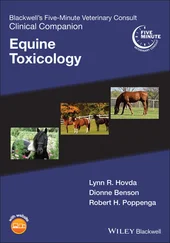Javier G. Nevarez - Blackwell's Five-Minute Veterinary Consult - Reptile and Amphibian
Здесь есть возможность читать онлайн «Javier G. Nevarez - Blackwell's Five-Minute Veterinary Consult - Reptile and Amphibian» — ознакомительный отрывок электронной книги совершенно бесплатно, а после прочтения отрывка купить полную версию. В некоторых случаях можно слушать аудио, скачать через торрент в формате fb2 и присутствует краткое содержание. Жанр: unrecognised, на английском языке. Описание произведения, (предисловие) а так же отзывы посетителей доступны на портале библиотеки ЛибКат.
- Название:Blackwell's Five-Minute Veterinary Consult: Reptile and Amphibian
- Автор:
- Жанр:
- Год:неизвестен
- ISBN:нет данных
- Рейтинг книги:4 / 5. Голосов: 1
-
Избранное:Добавить в избранное
- Отзывы:
-
Ваша оценка:
- 80
- 1
- 2
- 3
- 4
- 5
Blackwell's Five-Minute Veterinary Consult: Reptile and Amphibian: краткое содержание, описание и аннотация
Предлагаем к чтению аннотацию, описание, краткое содержание или предисловие (зависит от того, что написал сам автор книги «Blackwell's Five-Minute Veterinary Consult: Reptile and Amphibian»). Если вы не нашли необходимую информацию о книге — напишите в комментариях, мы постараемся отыскать её.
STAY UP TO DATE ON THE BEST PRACTICES FOR TREATING COMMON DISEASES IN REPTILES AND AMPHIBIANS Blackwell’s Five-Minute Veterinary Consult: Reptile and Amphibian
Blackwell’s Five-Minute Veterinary Consult: Reptile and Amphibian
Blackwell's Five-Minute Veterinary Consult: Reptile and Amphibian — читать онлайн ознакомительный отрывок
Ниже представлен текст книги, разбитый по страницам. Система сохранения места последней прочитанной страницы, позволяет с удобством читать онлайн бесплатно книгу «Blackwell's Five-Minute Veterinary Consult: Reptile and Amphibian», без необходимости каждый раз заново искать на чём Вы остановились. Поставьте закладку, и сможете в любой момент перейти на страницу, на которой закончили чтение.
Интервал:
Закладка:
Compact Fluorescent
Compact fluorescent bulbs can be fitted into any incandescent fixture that would fit a household bulb but a reflective or reptile‐specific fixture is preferred. The light is focused over a smaller area so there is less scattered radiation. For this reason, it is possible that a 10.0 compact fluorescent may actually emit a higher UVB output than a 10.0 linear fluorescent over the same area. It is usually recommended to place these bulbs next to the heat lamp so the reptile gets UVB exposure while basking. All other properties are similar to the linear fluorescent bulbs although some may think of these as being less effective and being “weaker” in the UVB spectrum.
Mercury Vapor Bulbs
Mercury vapor bulbs have been successfully used by breeders and zoological institutions for decades but have just recently made it into the mainstream exotic pet market. Their external appearance is that of a floodlight and they are commonly found as a self‐ballasted variety in the pet trade. Self‐ballasted bulbs can be fitted into an incandescent fixture that would fit a household bulb but a reflective or reptile‐specific fixture is preferred. A fixture with a ceramic base is also recommended because of the high amount of heat the bulbs produce. The light is focused over a shorter area so there is less scattered radiation. Their UVB output is based on the wattage of the bulb and the fixture should accommodate the appropriate wattage. Their effective distance is 12–36 inches. There are also some high‐output bulbs with an effective distance of up to 8 feet. A major advantage is the production of heat and a stronger UVB output compared with all other bulb types. In the hands of inexperienced individuals, however, these bulbs could be detrimental to reptiles. If placed too close to the animal, they could cause thermal damage. There is also a concern about overexposure to UVB, which could cause eye damage and even neoplasias. It is imperative that these bulbs are used properly; the author only recommends them for zoological institutions and advanced hobbyist who understand the principles of UVB exposure in reptiles. They must be replaced every 3–‐12 months, depending on manufacturer, model, and use.
METAL HALIDE BULBS
Metal halide bulbs are becoming more commonly available. They produce heat, UVB, and infrared light. Their beam is very narrow compared to all other bulb types which means that they can provide very high UVB levels but over a narrow area, which may be a positive feature in some enclosures (e.g., tall enclosures) but dangerous in others (e.g., short enclosures). These bulbs require external ballast and a properly rated fixture for operation and safety. Their use is best reserved for advanced hobbyist familiar with the principles of UVB lighting.
UVB REDUCTION
As previously mentioned, the type of material present between the bulb and the animal is an important consideration when selecting a UVB bulb. Most glass and plastics are known to block or filter out UVB radiation and are not recommended. The ideal scenario is one of an open‐topped enclosure with no material present between the bulb and the animal. While this is a possible application for chelonians, it is not feasible when housing snakes and some lizard species. A study by Burger et. al. revealed the UVB attenuating effects of common materials used in reptile enclosures and provides a sobering insight into the use of UVB bulbs (Burger et al, 2007).
The type of material, aperture of the openings, thickness, and reflective properties can all influence UVB attenuation and can significantly decrease the UVB exposure of reptiles. Most reptile enclosures have a screen or wire mesh top to keep the animals from escaping. Some of these screens may reduce the UVB light exposure to the animal by as much as 50%. To put this in perspective, if a reptile had a 10.0 linear fluorescent bulb, the effectiveness of that bulb might be reduced to that of a 5.0 by the time the light passes the screen and reaches the animal. This is why knowing the type of screen material is critical when selecting a bulb. A general recommendation is to select a screen with the largest aperture possible and with a mat or painted finish that will reflect less light.
SELECTING BULBS BASED ON SPECIES
There is a common trend toward make recommendations of bulbs based on the species with which it will be used. The principle behind this makes sense but in practice it is flawed. The thought is that tropical, desert or diurnal species require higher UVB exposure and therefore a stronger UVB bulb, while more temperate, or forest species require a lower UVB exposure and therefore a weaker bulb. These principles would hold true in open‐topped enclosures without a lid or when the bulb is placed inside the enclosure. However as mentioned previously, when the bulb is placed atop a screen, it can block a significant portion of the UVB reaching the animal. Therefore the author recommends selecting a bulb not simply based on the species but rather a combination of the species and the specific enclosure set‐up for the particular animal. There have been some cases in which animals where overexposed to UVB due to manufacturing errors in some UVB bulbs. As a consequence, some people believe that 10.0 bulbs are too strong and harmful for reptiles. This is not the case. In fact, it is difficult to replicate the natural UVB exposure from the sun and most bulbs cannot replace natural sunlight. It is rather the erroneous use of UVB bulbs that can lead to problems. Even a 2.0 bulb could cause problems if the reptile is allowed to come in direct contact with the bulb, as this is not the intended use. Buying a UVB bulb from a reputable manufacturer that provides clear guidance as to how to use the bulbs is the first step in the safe use of UVB bulbs. The second aspect is ensuring that the owners and caretakers are indeed using the bulbs in the safest, most efficient manner for the particular species.
MEASURING UVB
Another challenge in selecting the proper UVB bulb is the fact that bulb strength or percentage UVB emission does not directly translate to its effectiveness in stimulating vitamin D3 synthesis in the body. There are in vitro models to assess the efficiency of UVB light (Burger et al, 2007) but these are impractical in a clinical setting. We must rely on the reputation of the manufacturer to ensure the bulb is of good enough quality. How much UVB a particular reptile species requires is another question, without a clear answer. In general terms, reptiles should have exposure to a minimum of 13–20 μW/cm 2UVB irradiance with tropical species needing as much as 30–40 μW/cm 2, and desert species requiring as much as 150 μW/cm 2. Much research is needed to confirm this information, but it is a starting reference point. In nature, UVB exposure will vary with time of day, cloud covering, and so on, but in captivity the exposure level will be fairly constant while the bulb is turned on. Providing hiding places and a gradient of UVB light can help to reduce UVB overexposure although in practice overexposure is not as common of an event.
One practical option is to measure the UVB irradiance using a hand‐held radiometer. While expensive (approximately $250.00) these units are available to the general public. Their accuracy has been questioned, but they remain a good tool for the average reptile owner. A radiometer can be used to measure UVB irradiance of a bulb at any distance to determine how much UVB is being emitted and to record the decay of transmission over time. For example a 10.0 linear fluorescent bulb may emit 50 μW/cm 2at 12 inches when first purchased but after 6 months, the irradiance at 12 inches may have decreased to 25 μW/cm 2. While this may still be acceptable exposure, it certainly indicates decrease in the bulb’s effectiveness over time. This decay is normal but if one desires to provide a more constant UVB exposure year round, it may be time to purchase a new bulb. They can also be used to evaluate the effect of the screen or mesh cover on the effectiveness of a bulb to help clients select the most appropriate bulb for their set‐up. Some newer radiometers measure ultraviolet index providing scale from minimum to very high while others provide readout based on the Ferguson zones to help determine the UVB exposure. These radiometers are advertised as being able to measure the appropriate UVB dose for vitamin D3 synthesis although that claim has not been verified.
Читать дальшеИнтервал:
Закладка:
Похожие книги на «Blackwell's Five-Minute Veterinary Consult: Reptile and Amphibian»
Представляем Вашему вниманию похожие книги на «Blackwell's Five-Minute Veterinary Consult: Reptile and Amphibian» списком для выбора. Мы отобрали схожую по названию и смыслу литературу в надежде предоставить читателям больше вариантов отыскать новые, интересные, ещё непрочитанные произведения.
Обсуждение, отзывы о книге «Blackwell's Five-Minute Veterinary Consult: Reptile and Amphibian» и просто собственные мнения читателей. Оставьте ваши комментарии, напишите, что Вы думаете о произведении, его смысле или главных героях. Укажите что конкретно понравилось, а что нет, и почему Вы так считаете.












